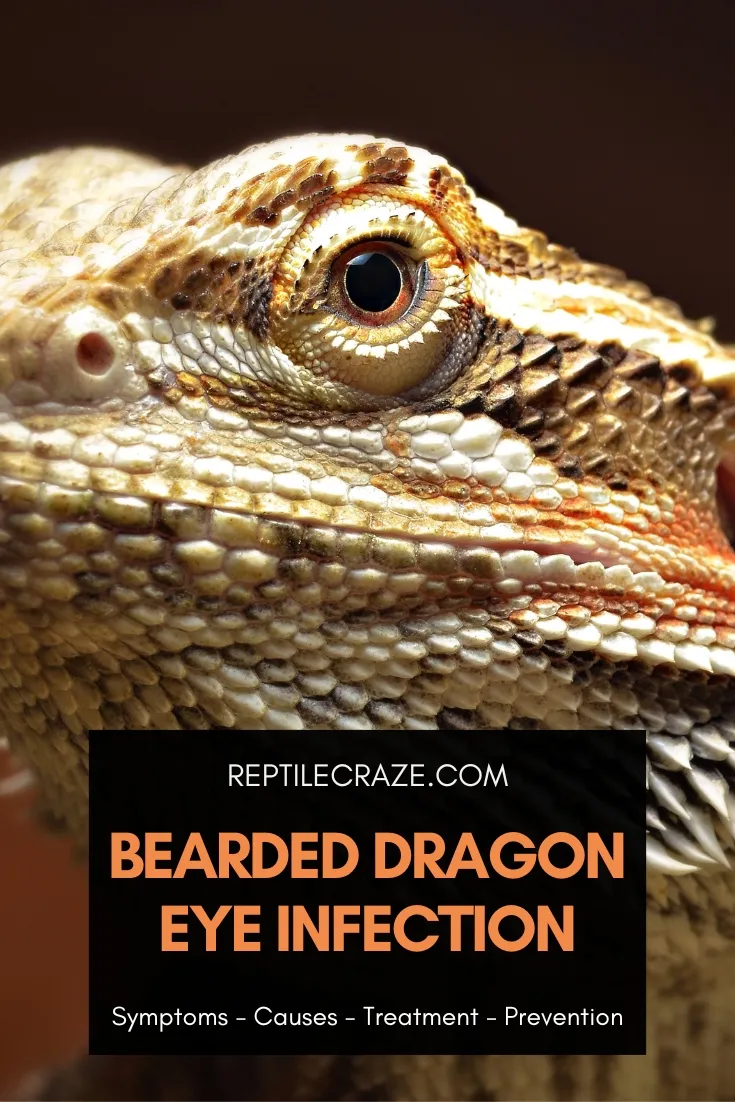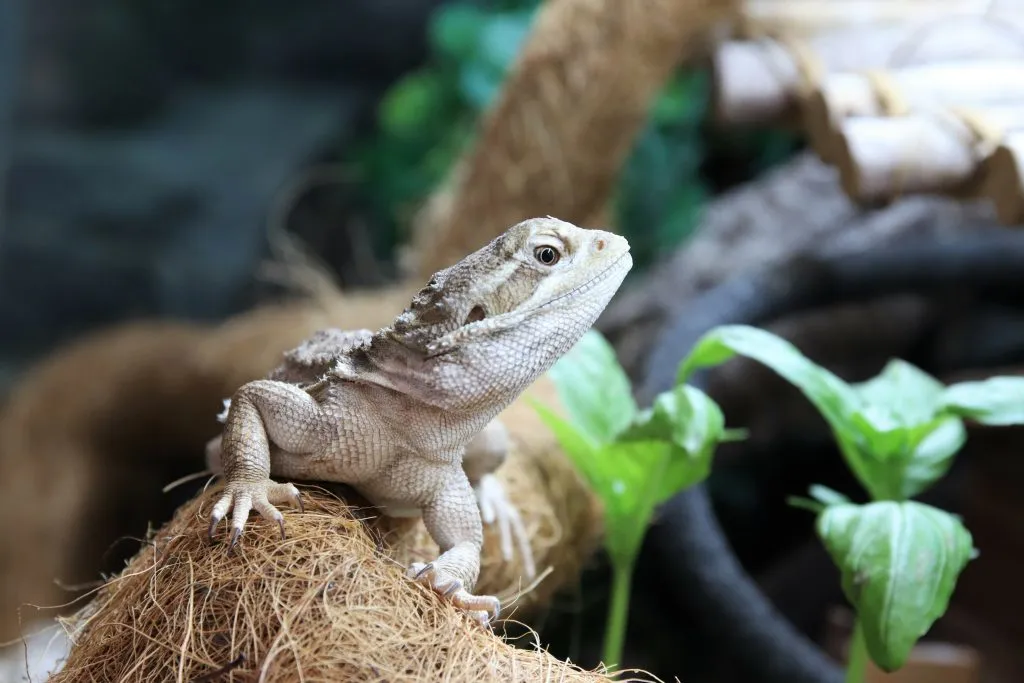
Even though reptiles’ eyes are slightly different from those of mammals or birds, it doesn’t mean they are any less susceptible to eye infections. In fact, many of the causes of eye infections in mammals and birds can also cause eye infections in beardies.
Infectious diseases, poor husbandry, inappropriate diet can cause eye infections in bearded dragons. An infected eye in bearded dragons is often red, swollen, and has discharge. It can be treatable following a veterinary examination and medication.
In this article, we’ll explain the following details you need to know about eye infections in bearded dragons:
- Symptoms
- Causes
- Diagnosis
- Treatment
- Prevention
Table of Contents
How To Know If Your Bearded Dragon Has An Eye Infection
Healthy bearded dragon eyes will be bright, shiny, alert, and completely open without any swelling or material exiting the eye. In terms of size and shape, they should be pretty symmetrical.
Eye-related symptoms that suggest your beardie has an eye infection include:
- Swelling
- Cloudiness
- Dull appearance
- Wounds or bleeding
- Keeping the eye closed
- Material exiting or surrounding the eye (fluid, mucus, or crusts)
Disclaimer: Please refer to the list above as a guide only. If you think your bearded dragon might have an eye infection, contact a reptile veterinarian.
Can a Bearded Dragon Die From An Eye Infection?

It’s pretty unlikely that a beardie will die from an eye infection, but it doesn’t mean it’s not possible. It depends on the reason behind the eye infection.
Un-resolved husbandry problems (such as inappropriate substrate or diet) may manifest in the beginning only as an eye infection but may be accompanied by more serious undetected problems.
Any condition can progress to something more serious if it remains untreated. If you notice any changes in your beardie’s health or behavior, contact a reptile specialist veterinarian to get a proper diagnosis.
Don’t forget an early diagnosis increases the chances of a full recovery for your beardie!
What Causes Eye Infections In Bearded Dragons?
In this section, we’ll explain the causes of eye infections in bearded dragons. Understanding the causes of problems in beardies gives us knowledge that can help prevent future diseases in your beardie.
1. Tear Duct Blockage
The tear duct (nasolacrimal duct) is a special structure through which tears flow to your beardies eye. Tears are important to prevent the eye from drying out and to flush away harmful microorganisms.
Tear ducts can become blocked by tumors or injuries, leaving the eye particularly susceptible to infection. Blocked tear ducts can have a link to Vitamin A deficiency (we’ll talk about that later).
Beardies have separate tear ducts for each eye. This means that if one becomes blocked, the other could still function.
2. Ulcers
Ulcers form when there is mechanical damage caused to the front part of the eye (the cornea). Corneal ulcers can occur due to sharp objects in your beardie’s enclosure or any kind of trauma to the eye.
Once the surface of the eye is damaged, it offers the perfect spot for harmful microorganisms to enter the body and cause an infection.
3. Vitamin A Deficiency

A lack of vitamin A can cause special cells to grow and block a beardie’s tear duct (nasolacrimal gland).
Since the tears are not able to reach the eye, it’s less protected from harmful microorganisms, and infections can develop.
4. Sand Substrate
If you decide to use sand as a substrate in your Beardies enclosure, be aware that it can contribute to eye infections. This is because the small, dusty particles can be irritating to their eyes.
Sand is not recommended for use as a substrate in a beardie’s enclosure because of its risk of causing impaction or constipation if ingested.
5. Pet Shop Bearded Dragons
Buying reptiles from pet shops comes with a risk that your beardie might not be completely healthy.
The combination of stress and overcrowded conditions these reptiles are often housed in means that they can have health conditions before you even take them home.
Sadly, bearded dragons in pet shops are not always looked after by staff who know how to care for them properly.
This means that they often have unsuitable living conditions and are more susceptible to diseases, such as eye infections.
Pro tip – always buy your pets from reputable breeders to minimize the risk of any health problems in your bearded dragon.
How To Treat Eye Infections In Bearded Dragons
Treatment for eye infections in bearded dragons is best done by a veterinarian who will examine the eye and perform other diagnostic techniques before continuing with the treatment.
A veterinarian will ask you questions about your beardie’s diet, enclosure (including environmental parameters and substrate), and circumstances surrounding the possible eye infection.
The treatment will vary depending on the cause of the eye infection. Below we’ve listed some common treatment options for eye infections in beardies related to their cause:
- Tear duct blockage – flushing or removing the block, then medication to treat the infection.
- Ulcers – medication to treat the infection and possibly a surgical procedure to heal the ulcer.
- Hypovitaminosis A – medication to treat the infection and correction of the diet to include all vitamins and minerals in their appropriate amounts.
- Sandy substrate irritation – removal of the old substrate and replacement with a suitable one, and medication to treat the infection.
Home Remedies For Eye Infections In Bearded Dragons

The best way to treat an eye infection in a bearded dragon is to take the animal to a reptile specialist veterinarian.
If you are not able to do this straight away, we’ve listed a few things you can do in the meantime below:
- You can use these eye drops for your bearded dragon’s eye infection
- Let your beardie have a soak in warm water.
- Carefully and gently remove any fluid or crusts from around the eye.
- Correct any dietary or enclosure insufficiencies immediately.
Often eye infections in bearded dragons require treatment with antibiotics which are only available following a consultation and prescription from a veterinarian.
While it may help, we don’t recommend using eye drops on your beardie without talking to a reptile specialist veterinarian first. So make sure to call a herp vet before doing so.
Eye Infections In Bearded Dragons: Prevention
As you can see, many of the causes of eye infections in beardies occur due to incorrect husbandry. This is great news because it means you, as the pet parent, can help prevent them.
Below, we’ve listed some tips to help reduce the chances of your beardie getting an eye infection:
- Make sure the environmental parameters in your beardie’s enclosure are always appropriate.
- Ensure that all the components (such as substrates, decorations, and plants) of your beardie’s enclosure are safe for beardies.
- Clean and disinfect your beardie enclosure and all its components regularly.
- Take your bearded dragon for frequent check-ups to a reptile veterinarian.
- Feed your beardie a diet that satisfies all their nutritional requirements.
- Keep a close eye on your bearded dragon so that you spot any changes early on.
You can read about everything you need to know about bearded dragon care in our guide.
Conclusion
As you can see, there are many causes of eye infections in bearded dragons. With many of them being preventable by practicing good husbandry and care for your beardie.
If you’re interested in learning more about bearded dragon eyes and their possible diseases, check out our articles on:
Have you had an interesting experience with an eye infection in a bearded dragon and want to help other owners? Tell us about it in the comments below!
- Enchi Ball Python: A Unique and Stunning Morph of Python regius - March 27, 2025
- Emerald Tree Monitor: The Enigmatic Green Guardian of the Rainforest - March 26, 2025
- The Egyptian Cobra (Naja haje): A Fascinating Serpent - March 25, 2025
